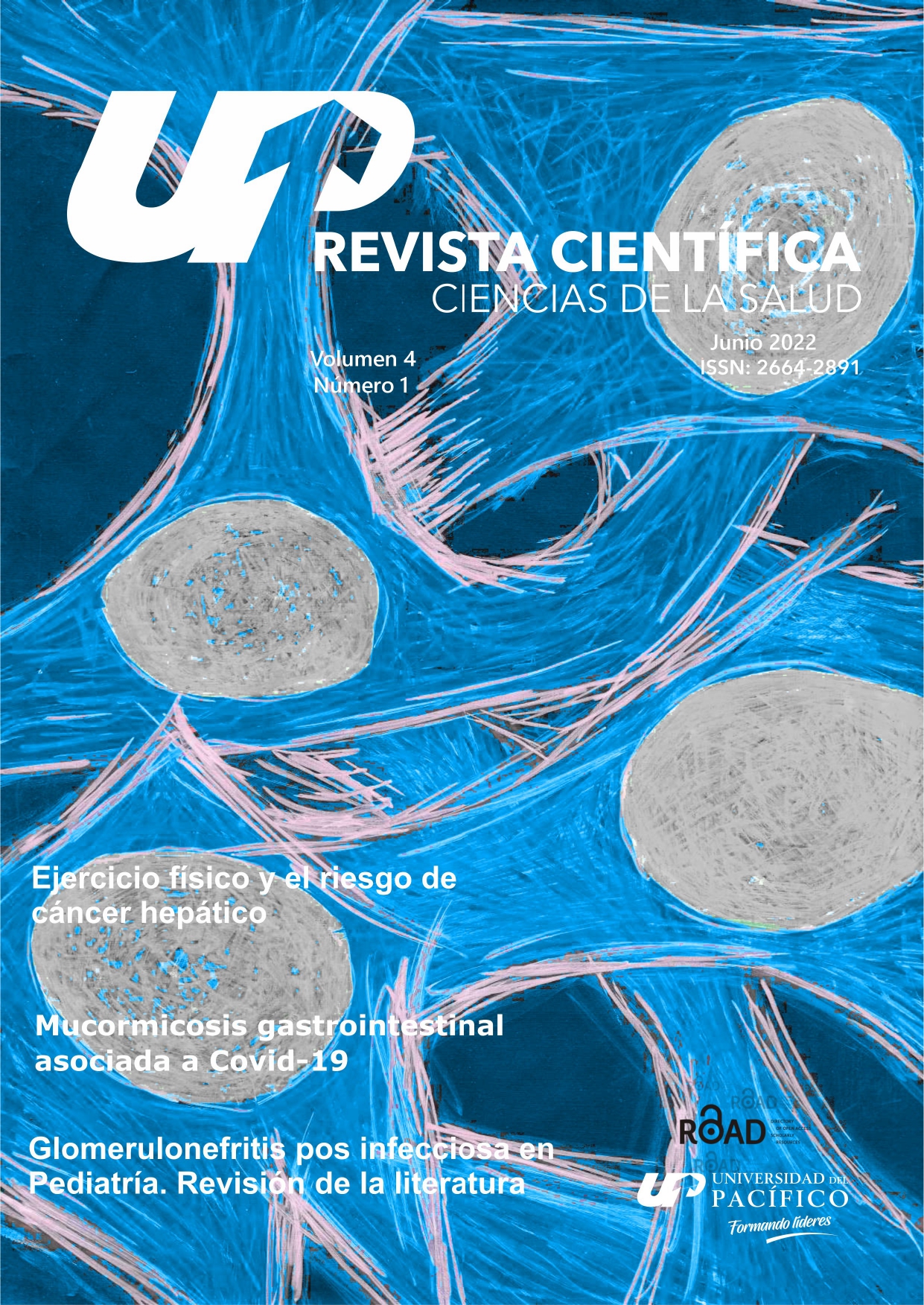Riesgo cariogénico en pacientes pediátricos de la Universidad del Pacífico en el año 2021
Cariogenic risk in pediatric patients of the Universidad del Pacifico in 2021
DOI:
https://doi.org/10.53732/rccsalud/04.01.2022.17Keywords:
Dental caries, Cariogenic risk level, Pediatric dentistryAbstract
Dental caries is considered a multifactorial disease that affects most of the world population and is considered to be the most prevalent disease of the oral cavity. There are several factors that play a very important role in the onset and progress of caries such as the host, time, substratum and microorganisms. On the other hand, the level of cariogenic risk can be defined as the probability of developing this disease, depending on several factors related to behaviors and practices of the individual or of a community. It is possible to prevent and reduce the risk associated with caries if the necessary care is taken into consideration, such as proper hygiene and a balanced diet. Objective: The main objective seeks to determine the most frequent cariogenic risk level in patients who attended the Pediatric Dentistry Clinic of the Universidad del Pacífico School of Dentistry in 2021. Methods: The research will be carried out as a cross-sectional descriptive observational study in which the risk table of the patients in the Pediatric Dentistry of the Universidad del Pacífico, was analyzed using the records and clinical histories of the patients. To load the data, the Microsoft Excel® computer program and the Epi Info ™ program were used according to descriptive statistics for subsequent analysis. Results: The most frequent risk level was the high level, which was present in 27 of the 66 patients, which is equivalent to 40.91% of the total patients. According to gender, it was established that the high-risk level was more frequent in the female sex (59.26%) in relation to that of the male sex (40.74%), while in the moderate risk level the male sex predominated (63.64%) unlike the female (36.36%) and finally the low risk was higher in male patients (58.82%) than in female patients witch was lower (46.97%). Conclusion: It was observed that most of the patients have a high level of cariogenic risk, being the sugar moments greater than three times a day, the most predominant factor followed by the presence of white spots or active lesions.
References
- Páez González Y, Tamayo Ortiz B, Peña Marrero Y, Méndez de Varona YB, Sánchez González M. Intervención educativa sobre caries dental en escolares de sexto grado. CCM. 2017; 21(4):1014-1024. http://scielo.sld.cu/scielo.php?script=sci_arttext&pid=S1560-43812017000400007&lng=es.
- Ministerio de Salud Pública y Bienestar Social. Encuesta nacional de salud bucodental del Paraguay, ENSABUD PY 2017: Del diagnóstico al diseño y la ejecución de políticas públicas de salud bucodental. Asunción: OPS/OMS- 2018. http://portal.mspbs.gov.py/bucodental/wp-content/uploads/2018/09/BUCODENTAL-PY-_2017_FINAL_AGOSTO-2018.pdf
- Cuyac Lantigua Ma, Reyes Martín B, Rodríguez Ramos SL, Sánchez Alvarado Y. Comportamiento de la caries dental en la escuela primaria Antonio López Coloma. Consejo Popular México. Colón, Matanzas. Mar.-jun., 2009. Rev. Med. Electrón. 2012; 34(2):153-161. http://scielo.sld.cu/pdf/rme/v34n2/tema05.pdf
- Nenen A, Courdurier C, Arcos A. Riesgo de Caries en Niños que Ingresan al Programa de Población en Control con Enfoque de Riesgo Odontológico. Int. J. Odontostomat. 2019; 13(4):437-441. http://dx.doi.org/10.4067/S0718-381X2019000400437.
- Featherstone JD, Adair SM, Anderson MH, Berkowitz RJ, Bird WF, Crall JJ et al. Caries management by risk assessment: consensus statement, April 2002. J Calif Dent Assoc. 2003; 31(3):257-269. https://www.mmclibrary.com/wp-content/uploads/2021/12/Caries-Management-by-Risk-Assessment-Consensus-Statement-April-2002.pdf
- Ramón Jimenez R, Castañeda Deroncelé Mo, Corona Carpio MH, Estrada Pereira GA, Quinzán Luna AM. Factores de riesgo de caries dental en escolares de 5 a 11 años. MEDISAN. 2016; 20(5):604-610. http://www.scielo.sld.cu/scielo.php?script=sci_arttext&pid=S1029-30192016000500003
- Navas R, Mejia M, Rojas -Morales T, Álvarez CJ, Zambrano O. Evaluación de un servicio odontológico público: niveles de riesgo a caries dental como indicadores de medición. Acta odontol. venez. 2006; 44(3):346-351. http://ve.scielo.org/scielo.php?script=sci_arttext&pid=S0001-63652006000300010&lng=es.
- Rodríguez Llanes R, Traviesas Herrera EM, Lavandera Carballido E, Duque Hernández M. Factores de riesgo asociados con la caries dental en niños de círculos. Rev Cubana Estomatol. 2009; 46(2):1-9. http://scielo.sld.cu/scielo.php?script=sci_arttext&pid=S0034-75072009000200006&lng=es.
- Gomez J. Peña R. La valoración del riesgo asociado a caries. Revista ADM. 2009. https://www.medigraphic.com/pdfs/adm/od-2014/od142c.pdf
-Sánchez L, Sáenz L, Molina N, Irigoyen M, Alfaro P. Riesgo a caries. Diagnóstico y tratamiento Revista ADM. 2018; 75(6):340-349. https://www.medigraphic.com/pdfs/adm/od-2018/od186h.pdf
- López A, Mateo M, Bratos E, Garcillán, M. Diagnóstico del riesgo de caries en los pacientes infantiles de la Universidad Complutense de Madrid. Odontol Pediátr. 2016; 24(3):183-193. https://www.odontologiapediatrica.com/wp-content/uploads/2018/05/315_03_Original_307_Lopez.pdf
- Ferreira Gaona M. Evaluación del estado de salud buco dental en menores en situación de calle, asistidos por la Fundación de Ayuda Republicana (FUNDAR). Paraguay: 2009-2010. Mem. Inst. Investig. Cienc. Salud. 2011; 9(1):21-34. https://revistascientificas.una.py/index.php/RIIC/article/view/1684/1642
- Gómez, P. Determinación del Riesgo Cariogénico Utilizando el Cuadro de Riesgo de la Ficha Clínica de Odontopediatría y el Programa Computacional Cariogram. Universidad de Talca, 2008. http://dspace.utalca.cl/handle/1950/6347


.png)














 All the contents of this journal are licensed under a
All the contents of this journal are licensed under a 